Introduction
The UF/IFAS strawberry breeding program at the UF/IFAS Gulf Coast Research and Education Center develops strawberry varieties for the Florida industry. These varieties are adapted to the unique conditions of central Florida and, as a result, have unique characteristics including low chilling requirement, high early yield, excellent shelf life, and outstanding flavor. These characteristics make these varieties useful outside of Florida as well, particularly in regions of the world where strawberries are grown in the winter and early spring. Currently, Florida strawberry varieties are grown in over 70 countries spread across six continents. The main objective of this Extension publication is to communicate the benefits of licensing UF/IFAS strawberries outside of the USA, with a special focus on Egypt. The target audience of this publication includes those involved in the strawberry industry as well as the general public.
A new UF/IFAS strawberry is commercialized on average every 2–3 years. During this process, the breeding program collaborates with Florida Foundation Seed Producers, Inc. (FFSP) and the Florida Strawberry Growers Association (FSGA) to develop foundation stock of new varieties and license them to nurseries so Florida growers will have a secure plant supply for the approximately 10,500 acres of strawberries grown in central Florida. Once these varieties are available to Florida growers, they can also become available in other regions of the globe that are not directly competitive with the Florida industry. To accomplish this, the FSGA partners with Ekland Marketing Company of California, Inc. (EMCO CAL), which is tasked with protecting, licensing, and marketing UF/IFAS strawberries outside the USA and Canada.
Multiple benefits can accrue from the international distribution of these varieties.
- The UF/IFAS strawberry breeding program and the overall UF/IFAS strawberry research effort benefit when international royalties are reinvested.
- A stronger breeding program is able to develop more and better varieties for our Florida stakeholders.
- Consumers around the world have more flavorful and healthy food options as a result of UF/IFAS varieties being grown in their regions.
- In developing countries, UF/IFAS varieties help support the growth of industries that in turn support local economies and quality of life.
This last benefit is vividly illustrated by the dramatic growth of the Egyptian strawberry industry in the last twenty years. The following sections will detail this success story as an example of the kind of benefits that have occurred around the world from the introduction of UF/IFAS strawberries. Certainly, it is important to introduce new strawberries to existing markets. The UF/IFAS varieties already have major market share in traditional strawberry-producing countries, including Australia, Mexico, Morocco, Spain, and Turkey. However, it is also an important role of EMCO CAL to support emerging markets and even to develop new markets around the world in places such as Costa Rica, Malaysia, India, Ethiopia, Ghana, Kenya, Rwanda, Sri Lanka, Nepal, and Mauritius as part of a total 75 countries around the world utilizing UF/IFAS strawberry varities.
Egypt: A UF/IFAS Strawberry Success Story
With its Mediterranean climate, Egypt has a cool winter lasting from November to March with a temperature range between 48°F and 65°F (9°C and 18°C) and a hot summer from May/ June to September with a temperature ranging from 91°F (33°C) in Cairo and the delta region to 106°F (41°C) in upper Egypt. These regions of Egypt enjoy a sunny climate year-round and have fertile soils. Strawberry varieties from UF/IFAS can be planted in the hot conditions of September and produce high early yields, allowing production in Egypt to start in early November (Figure 1B). This period coincides with a reduction in fresh strawberry volume on the worldwide market and thus higher prices. The winter season in Egypt stretches into the early spring, allowing a long export window to Europe, the Middle East, and other countries in Asia and Africa.
The Egyptian export market currently includes over 75 countries for individually quick-frozen (IQF) product and 55 countries for fresh strawberries (2023 data obtained from Arab Republic of Egypt Ministry of Trade and Industry, General Organization for Export and Import Control [GOEIC]). The total acreage of strawberries grown in Egypt (registered at the Ministry of Agriculture) in 2024 was about 50,000 acres compared to 40,000 acres in 2022. The UF/IFAS varieties’ market share as of 2023 was approximately 95% of this acreage. Looking farther back, the successful introduction of the UF/IFAS strawberry varieties to Egypt helped increase total Egyptian production from 77,840 metric tons in the year 2000 to around 638 metric tons in 2022, with an increase in the total planted area from 6,644 acres in 2000 to about 50,000 acres in 2023.
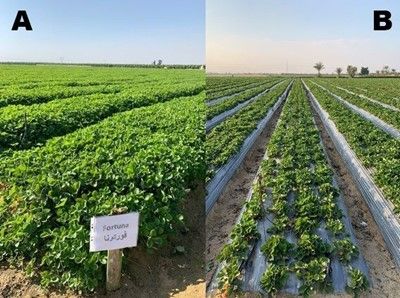
Credit: Fahiem E. EL-Borai, PICO agriculture, Egypt
UF/IFAS strawberry varieties were first introduced to Egypt in the late 1990s with ‘Sweet Charlie’. The flavor of this variety combined with its early yields was transformational for the industry. Production per acre in Egypt increased from 5–8 metric tons before ‘Sweet Charlie’ to 10–15 metric tons after its introduction. ‘Sweet Charlie’ was first introduced to Egyptian growers as frigo (dormant) plants that were planted from early September until mid-October and produced fruits from mid-February until May. Later, EMCO CAL began introducing UF/IFAS varieties as fresh plants that were planted at the same time but began producing in the first week of November. With this planting system and the continual introduction of new UF/IFAS varieties, the industry has never looked back. The average production of UF/IFAS varieties in Egypt now ranges from 22–30 metric tons/acre compared to 10–18 metric tons/acre in Florida, which has a shorter season.
Table 1. UF/IFAS strawberry varieties currently utilized in Egypt by year of introduction.
‘Strawberry Festival’ was introduced in 2004 (Table 1, Figure 2A). It was the first foreign plant variety to be protected by the Egyptian Plant Variety Protection Office (PVPO) and is protected by Egypt Plant Breeder’s Rights Certificate No. 1. ‘Festival’ was an important fresh-market variety in Egypt for several years. From 2009–2017, export of ‘Festival’ to the fresh market in Europe steadily decreased, but due to its unique and outstanding processing characteristics (firmness, sugar levels, and deep-red internal color), this variety grew to occupy nearly 100% of the acreage dedicated solely to IQF. Acreage and varieties dedicated to fresh export are largely converted to IQF in the late season when fresh prices drop, and so other varieties also contribute to the total IQF output in Egypt. In the last two years, ‘Festival’ has represented around 40% of the total IQF market, with the other 60% comprised primarily of Florida Fortuna™, Florida Beauty, Florida Brilliance, Florida Felicity™ and Sweet Sensation®.
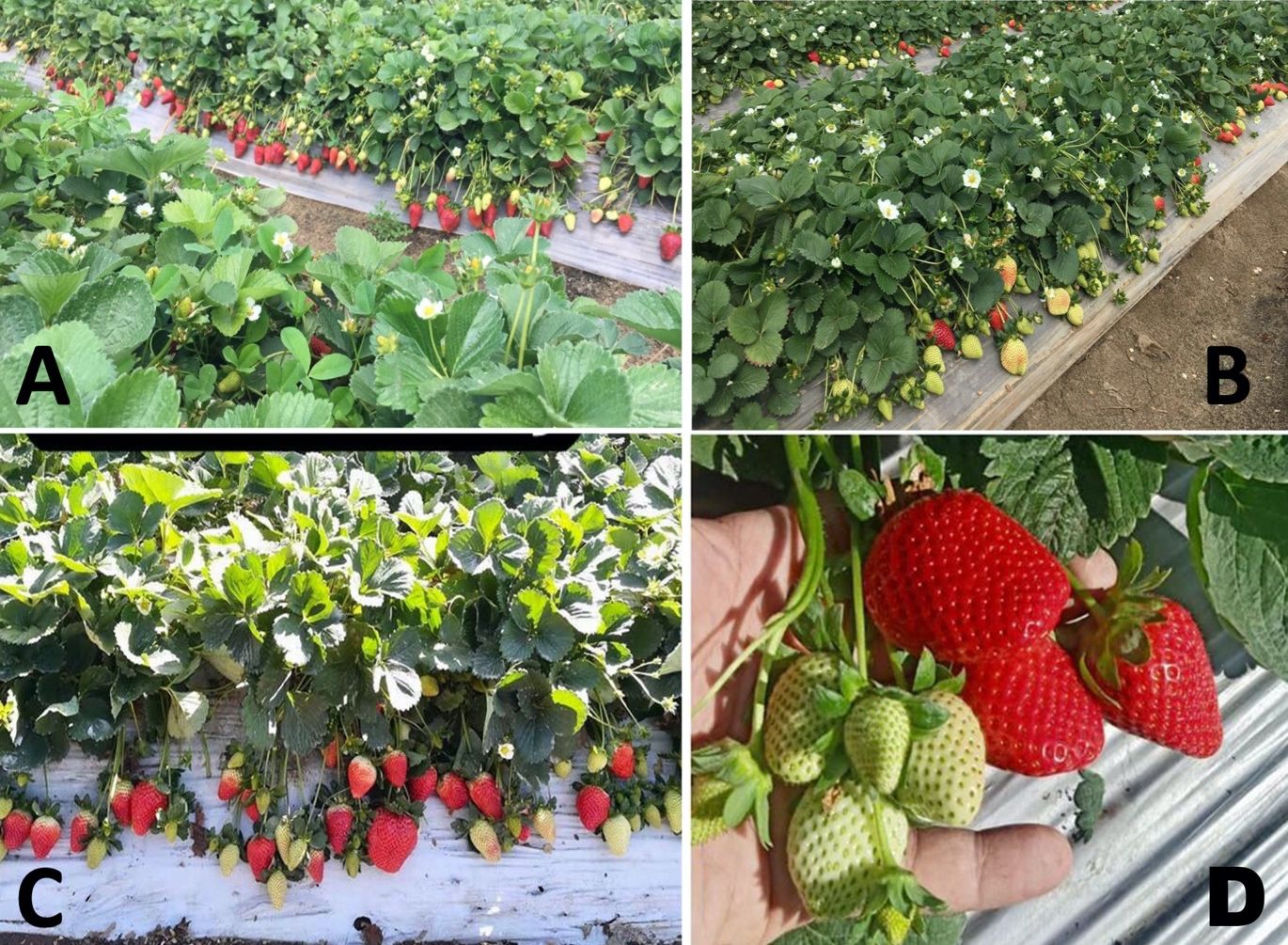
Credit: Emad Mahdy, Qaliobyia, Egypt
Fresh Export Sector
According to the Egyptian government, total fresh strawberry exports from Egypt have increased from 338 metric tons in 2000 to 44,695 metric tons in 2023 (Figure 3). Increases since 2006 coincided with an increase in EMCO CAL activities in Egypt. The main export market to Egypt is the Middle Eastern/Gulf countries followed by the EU (Figure 4). Belgium, Germany, the UK, the Netherlands, and France lead the European imports, with Saudi Arabia, Syria, UAE, Iraq and the Sultanate of Oman leading the Middle Eastern/Gulf countries. Egypt now ranks number six in the world for fresh strawberry exports after Spain, the United States, Mexico, the Netherlands, and Belgium. Because Spain and Morocco come into production later than Egypt, for a period of time each winter Egypt is the main supplier for the EU.
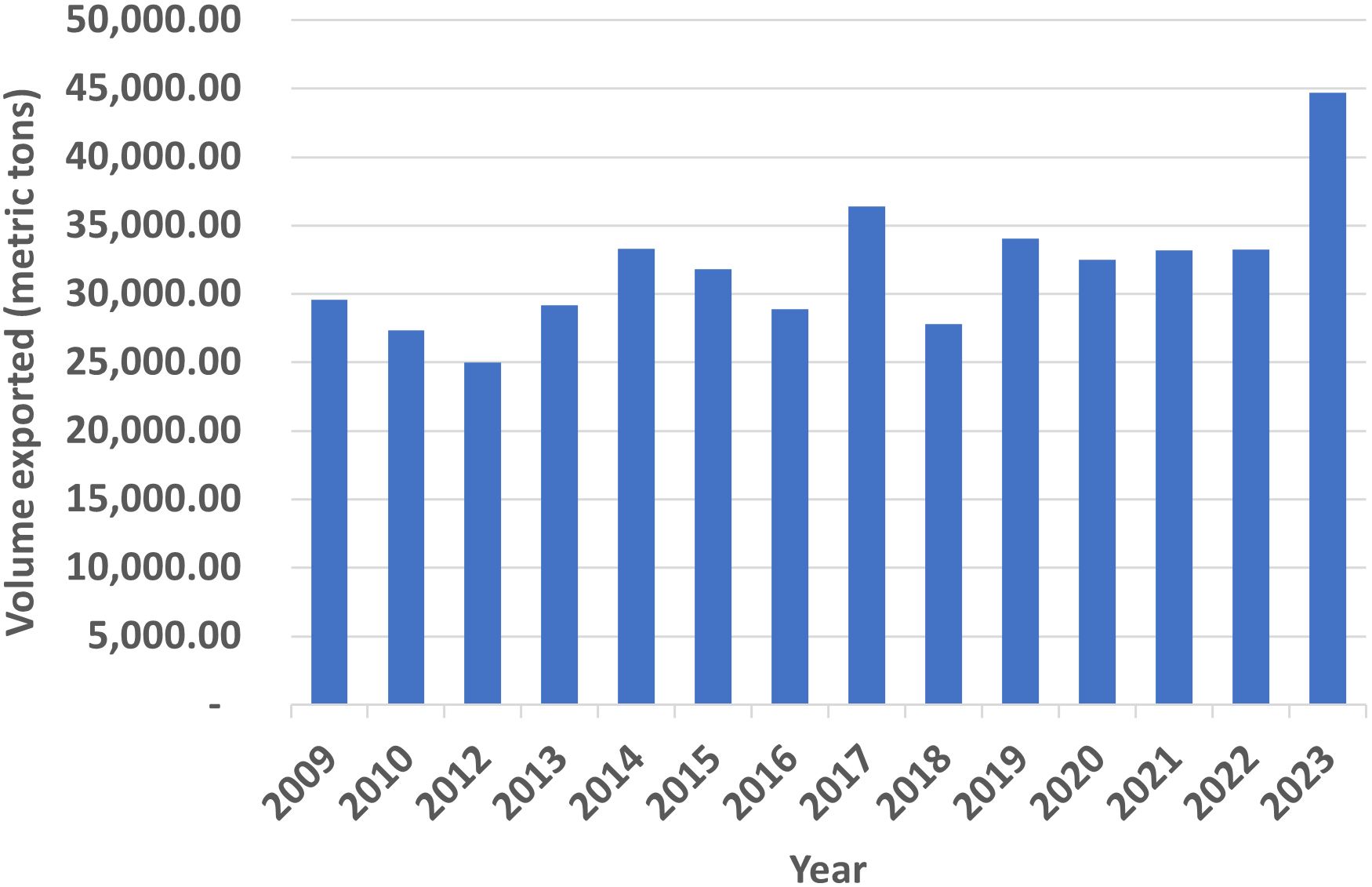
Credit: GOEIC, Egypt 2023
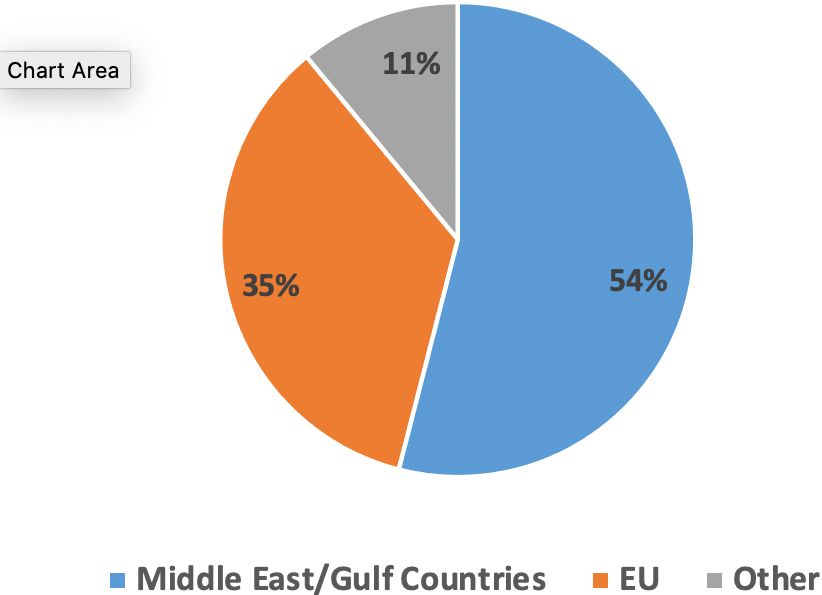
Credit: GOEIC, Egypt 2020
The breakdown of fresh exports by UF/IFAS strawberry variety for the 2019–2023 season is illustrated in Figure 5. Sensation® Brand ‘Florida127’ is the leading variety, followed by ‘Florida Fortuna’, Florida Festival and Florida Beauty.
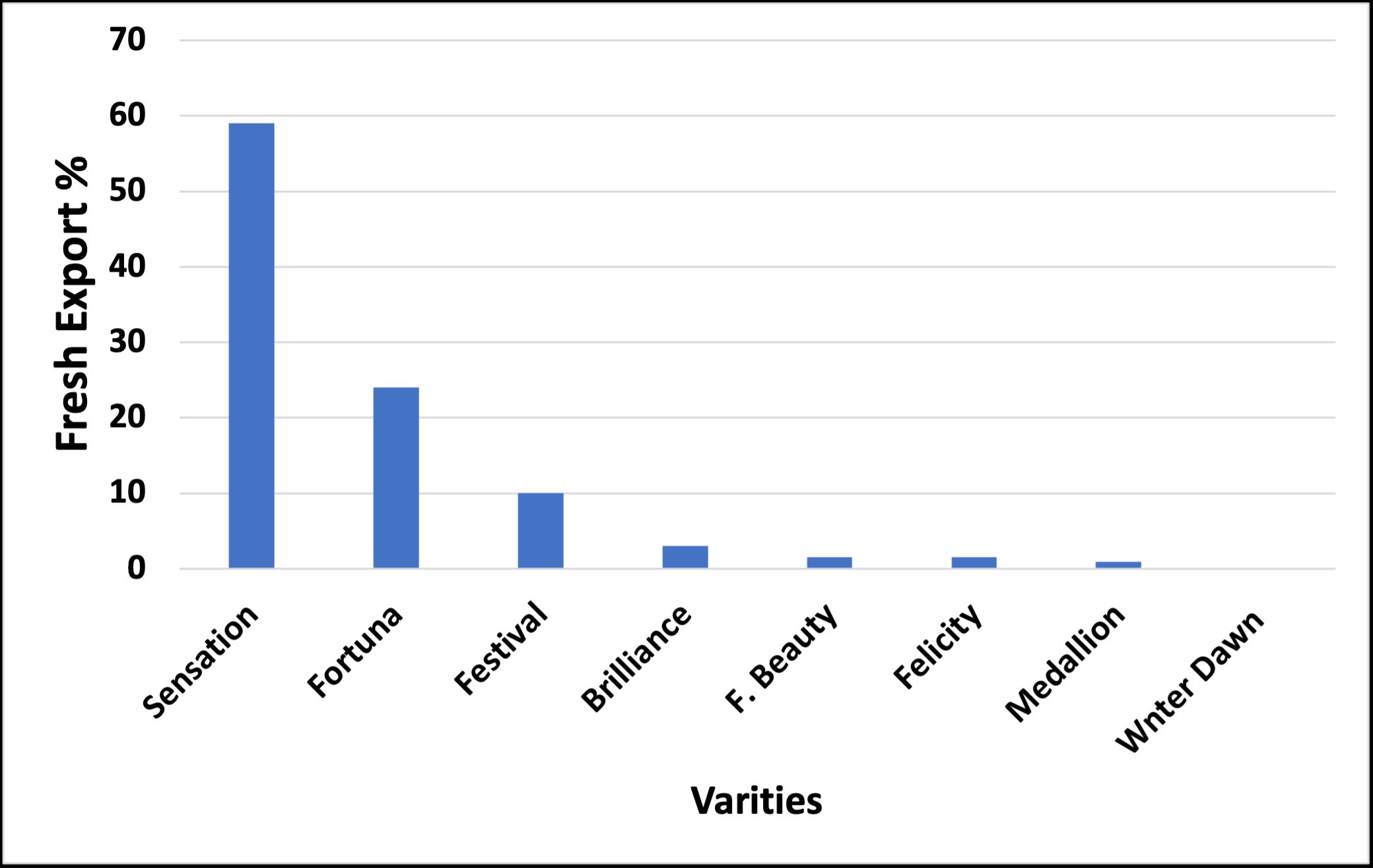
Credit: GOEIC, Egypt 2020
IQF Sector
Total exports of strawberry frozen fruit from Egypt have increased dramatically and steadily in the last 10 years (Figure 6) (GOEIC, Egypt 2023). Frozen-fruit exports began after the introduction of ‘Festival’, and now a mix of UF/IFAS strawberry varieties represent 95% of the IQF export. Since 2019, Egypt ranked first globally for IQF exports with 140,000 metric tons and a revenue of $165 million dollars compared to 244,147 metric tons export in 2023 with over 300 million dollar revenue. There is a 43% increase compared to 2019 and around 50% of the total world export, followed by Mexico, Poland, Chile, Morocco, and China (United Nations/International Trade Centre 2020).
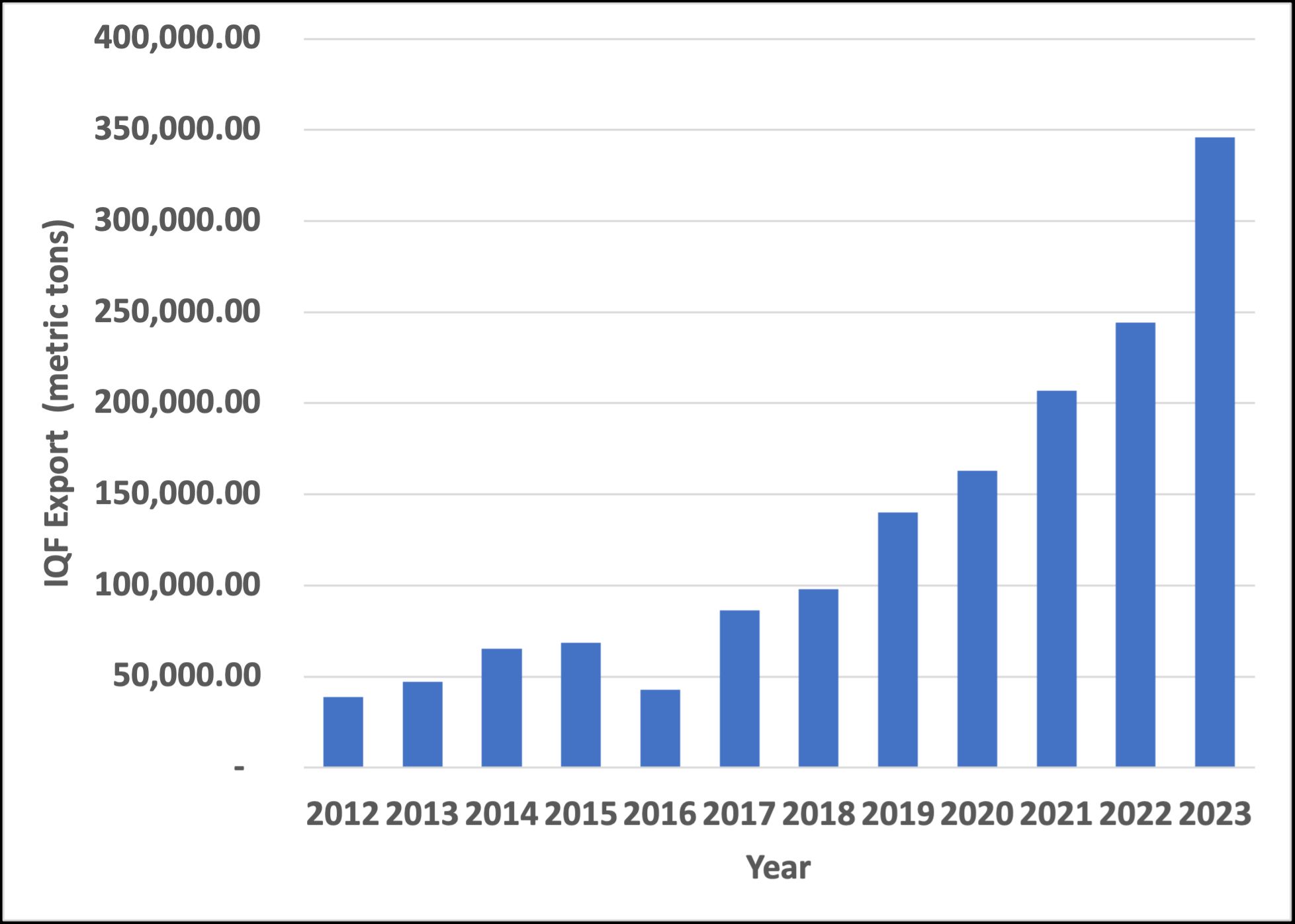
Credit: GOEIC, Egypt 2020
The main export regions for Egyptian IQF strawberries are Europe followed by the Middle Eastern/Gulf countries (Figure 7). In 2023, Germany, Russia, China, Poland, the Netherlands, Brazil, France, the USA, Belgium, and Italy were the top ten imported countries that import Egyptian frozen strawberries, with 12.6%; 11.6%; 11.2%; 9.2%; 8.6%; 5.5%; 4.1%; 3.8%; 3.7%; and 3.5% respectively, in addition to several other EU countries with a 52% of the total export. Saudi Arabia, Sudan, and Libya are the leading Middle Eastern/Gulf countries in 2023 import season, with 3.1%, 2.1%, and 1%, respectively. Other countries include United Kingdom, Japan, Guatemala, Spain, and Greece with 2.1%; 1.8%; 1.4%; 1.2%; and 1% of total export respectively, in addition to over 72 countries with less than 1%.
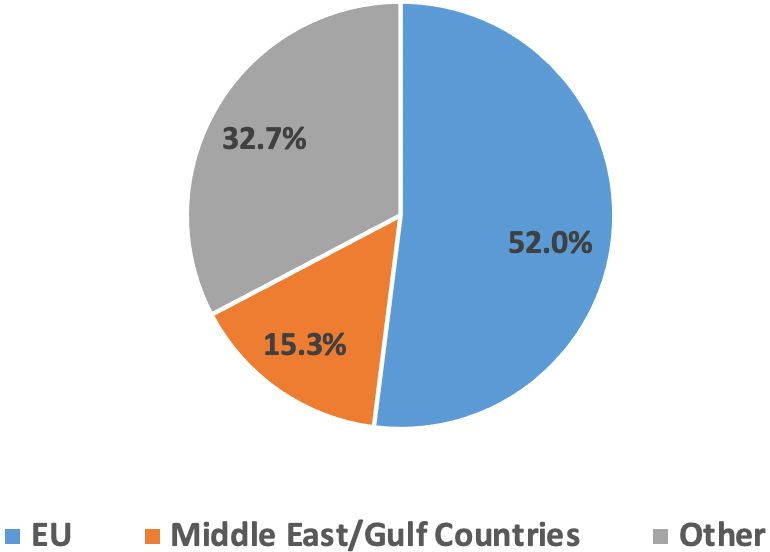
Credit: GOEIC, Egypt 2020
UF/IFAS Research and Extension Engagement
In August 2007, EMCO CAL invited a group of UF/IFAS strawberry scientists, led by Dr. Craig Chandler, to visit Egypt and examine UF/IFAS variety performance. Around this time, EMCO CAL heavily invested in Egypt to educate all interested parties about intellectual property rights. These efforts included visits to nursery and fruit production fields, technical support, workshops, lectures, field visits, and steady communication with growers and government officials. In July 2016, a collaborative research project was created between UF/IFAS and the National Research Center in Egypt titled “Preparing and Evaluating IPM Tactics for Increasing Strawberry and Citrus Production,” funded by USAID, NAS, and the Science and Technology Development Fund (STDF) of the Ministry of Higher Education in Egypt. Through this project, UF/IFAS collaborators, including Dr. Fahiem EL-Borai and Dr. Larry Duncan, visited Egypt once or twice a year to hold workshops and visit growers (Figure 8). In September 2019, UF/IFAS strawberry breeder Dr. Vance Whitaker visited Egypt to hold a one-day workshop on strawberry variety traits and management.

Credit: Mohamed Ashraf, PICO agriculture, Egypt
With the steady annual increase of strawberry growing acreage in Egypt with and the Egyptian strawberry industry for both fresh and frozen fruits export in the last 5 years, the University of Florida breeding program offers newer varities including Florida Medallion™ ‘FL 16.30-128’; Florida Felicity™ ‘FL 17.15-86’; and Florida Pearl™ ‘FL 16.78-109' in 2024. To accommodate the increase demand for the UF strawberry varities plants, EMCOCAL has initiated a certified strawberry nursery inside Egypt to fulfill the needs of the Egyptian strawberry growers as well as export the remaining plants to other countries around the globe. Figures 9 and 10 show EMCOCAL/Cal-Pacific Egypt open field nursery with various UF varities at two different times, in early November before the bare root mother plant harvest (Figure 9) and late December when bare root mother plants ready to be harvested as they reached to their dormant status. Frequent visits by UF/EMCOCAL team to oversee the nursery and progress has been going since the last visit by Dr. Vance Whitaker to Egypt late 2019 (Figure 10) with 4-6 annual visits by the EMCOCAL team annually.
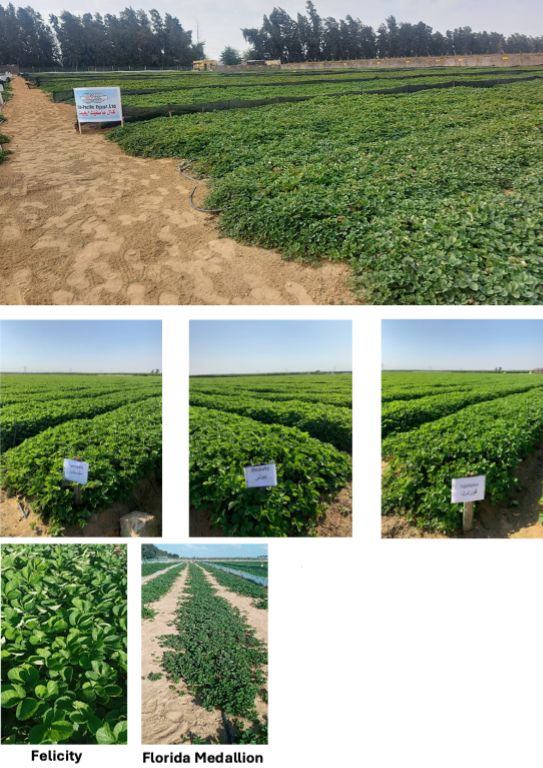
Credit: Fahiem E. Kora
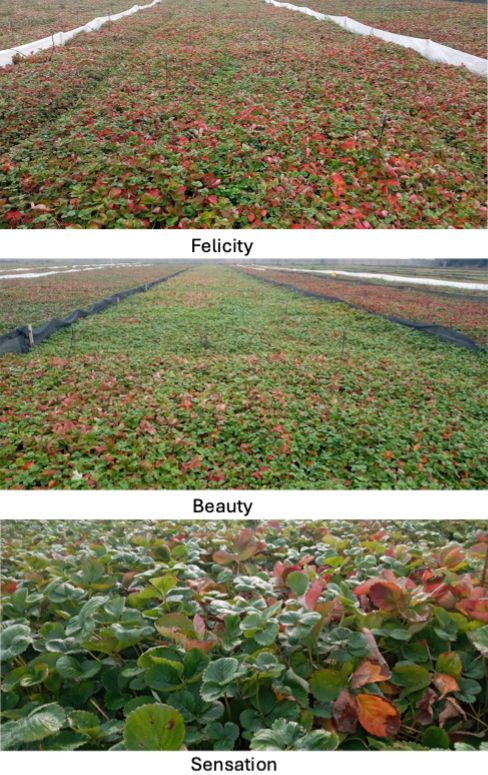
Credit: Fahiem E. Kora
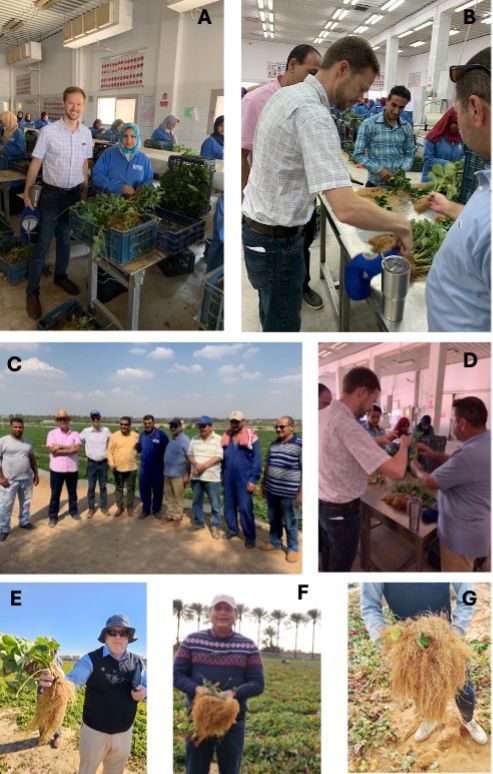
Credit: UF/IFAS
Conclusions
The introduction of UF/IFAS strawberry varieties to Egypt has helped fuel the growth of what is now one of the leading strawberry industries in the world. This success story illustrates the many benefits that can arise from global plant variety introduction efforts. UF/IFAS scientists are proud to be a part of supporting agriculture around the world through their research and Extension efforts, in particular to support the economic viability and quality of life for the people of developing nations.
Much work is still needed in Egypt to promote a healthy industry. In particular, it will be important to increase intellectual property rights enforcement. EMCO CAL has made significant progress in reducing illegal plant propagation and production, with 250 fresh export licenses and 108 IQF export licenses executed in 2023. Since 2020, the EMCOCAL/Cal- Pacific Egypt nursery has been exporting plants of UF strawberry varities to over 28 countries. However, there is still much work to be done to bring the whole industry into compliance. Continuing international research and Extension efforts will also be important to help sustain the success of the industry.
References
Arab Republic of Egypt, Ministry of Trade and Industry, General Organization for Export and Import Control (GOEIC). 2019. https://www.goeic.gov.eg/en
Arab Republic of Egypt, Ministry of Trade and Industry, General Organization for Export and Import Control (GOEIC). 2020. https://www.goeic.gov.eg/en
Chandler, C. K., E. E. Albregts, C. M. Howard, and J. K. Brecht. 1997. “ ‘Sweet Charlie’ Strawberry.” HortScience 32:1132–1133. https://doi.org/10.21273/HORTSCI.32.6.1132
Chandler, C. K., D. E. Legard, D. D. Dunigan, T. E. Crocker, and C. A. Sims. 2000. “ ‘Strawberry Festival’ Strawberry.” HortScience 35:1366–1367. https://doi.org/10.21273/HORTSCI.35.7.1366
Chandler, C. K., B. M. Santos, N. A. Peres, C. Joquand, A. Plotto, and C. A. Sims. 2009. “ ‘Florida Radiance’ Strawberry.” HortScience 44:1769–1770. https://doi.org/10.21273/HORTSCI.44.6.1769
Chandler, C. K., B. M. Santos, N. A. Peres, and C. Jouquand. 2009. “ ‘Florida Elyana’ Strawberry.” HortScience 44:1775–1776. https://doi.org/10.21273/HORTSCI.44.6.1775
United Nations/International Trade Centre. 2020. https://www.intracen.org/
Whitaker, V. M., C. K. Chandler, N. A. Peres, M. C. N. Nunes, A. Plotto, and C. Sims. 2015. “ ‘Sensation™ ‘Florida127’ Strawberry.” HortScience 50:1088–1091. https://doi.org/10.21273/HORTSCI.50.7.1088
Whitaker, V. M., C. K. Chandler, B. M. Santos, N. A. Peres, M. C. Nunes, A. Plotto, and C. Sims. 2012. “ ‘Winterstar™ 'FL 05-107' Strawberry.” HortScience 47:296–298. https://doi.org/10.21273/HORTSCI.47.2.296
Whitaker, V. M., L. F. Osorio, N. A. Peres, Z. Fan., M. Herrington, M. Cecilia do Nascimento Nunes, A. Plotto, and C. Sims. 2017. “ ‘Florida Beauty’ Strawberry.” HortScience 52:1443–1447. https://doi.org/10.21273/HORTSCI12281-17
Whitaker, V. M., N. A. Peres, L. F. Osorio, and Z. Fan. 2019. “ ‘Florida Brilliance' Strawberry.” HortScience 54:2073–2077. https://doi.org/10.21273/HORTSCI14327-19